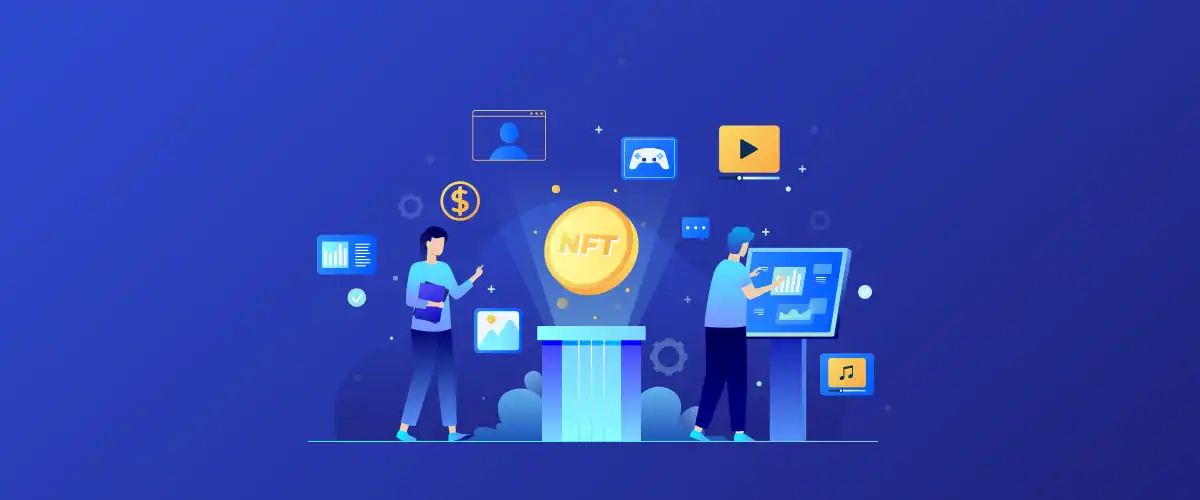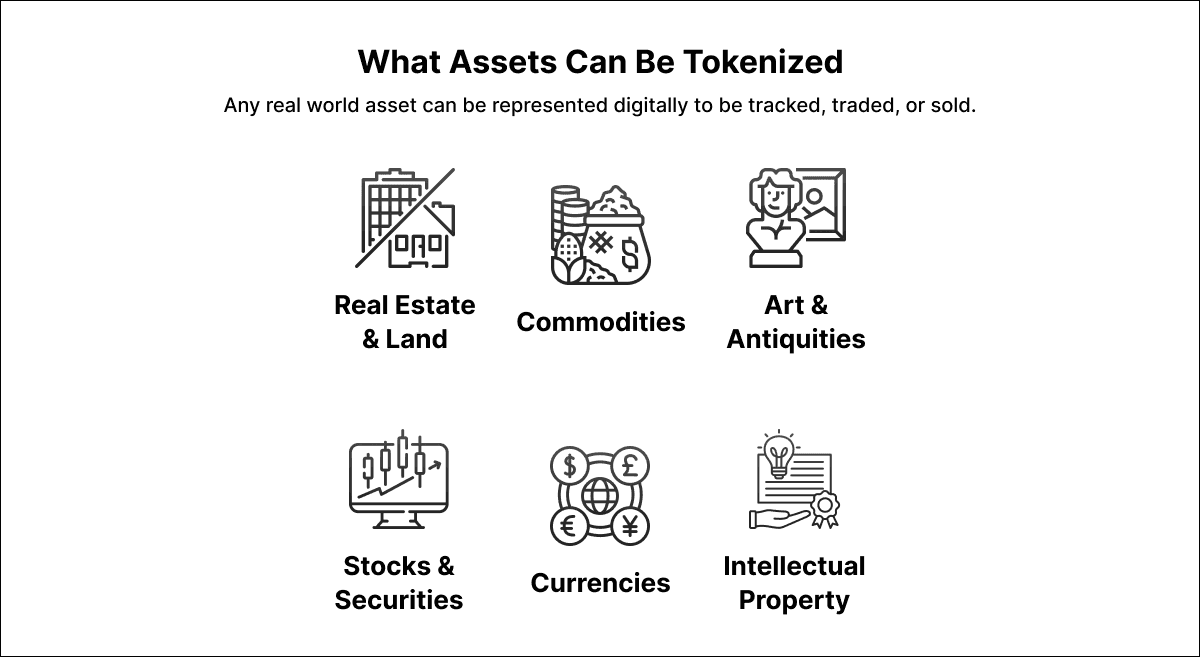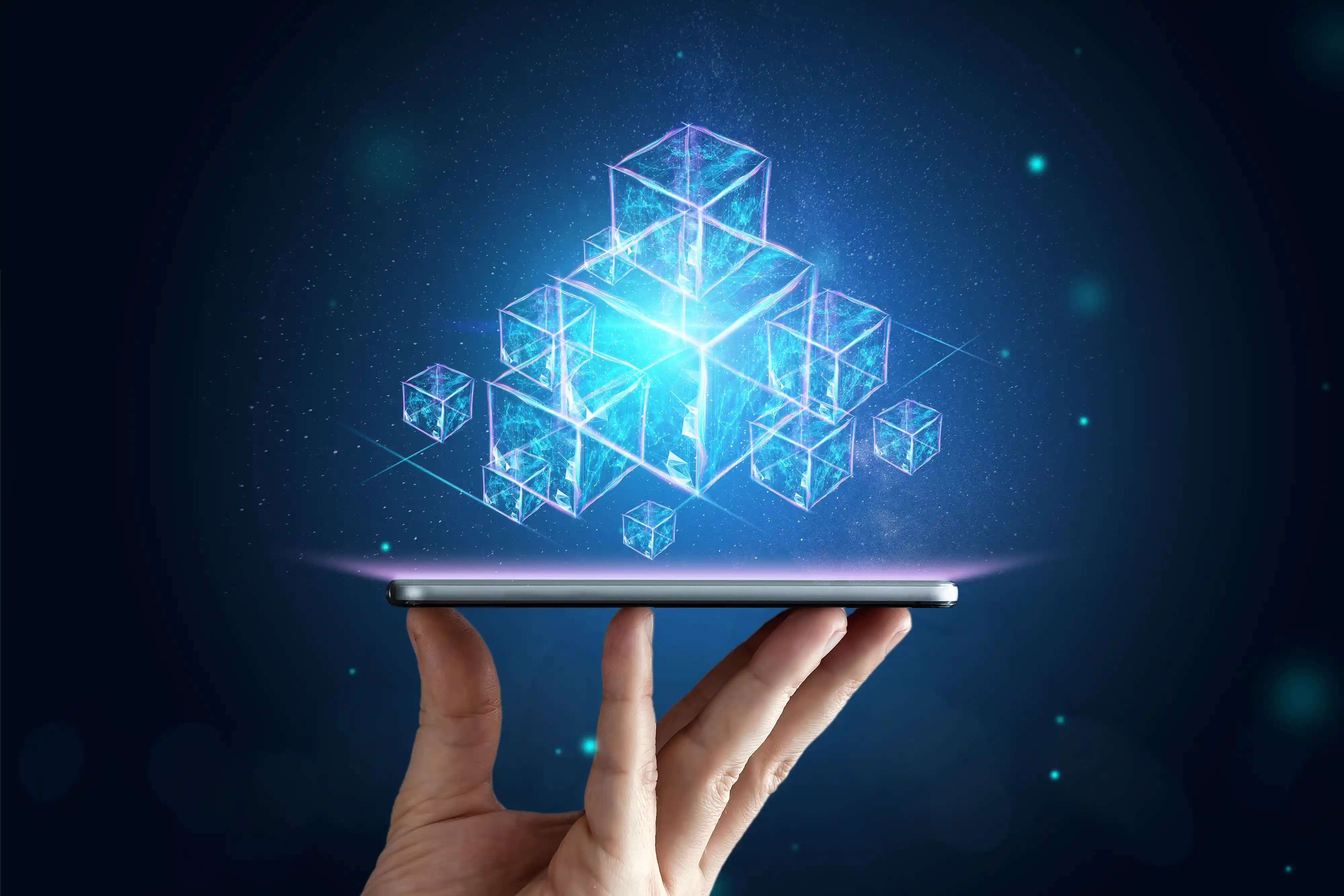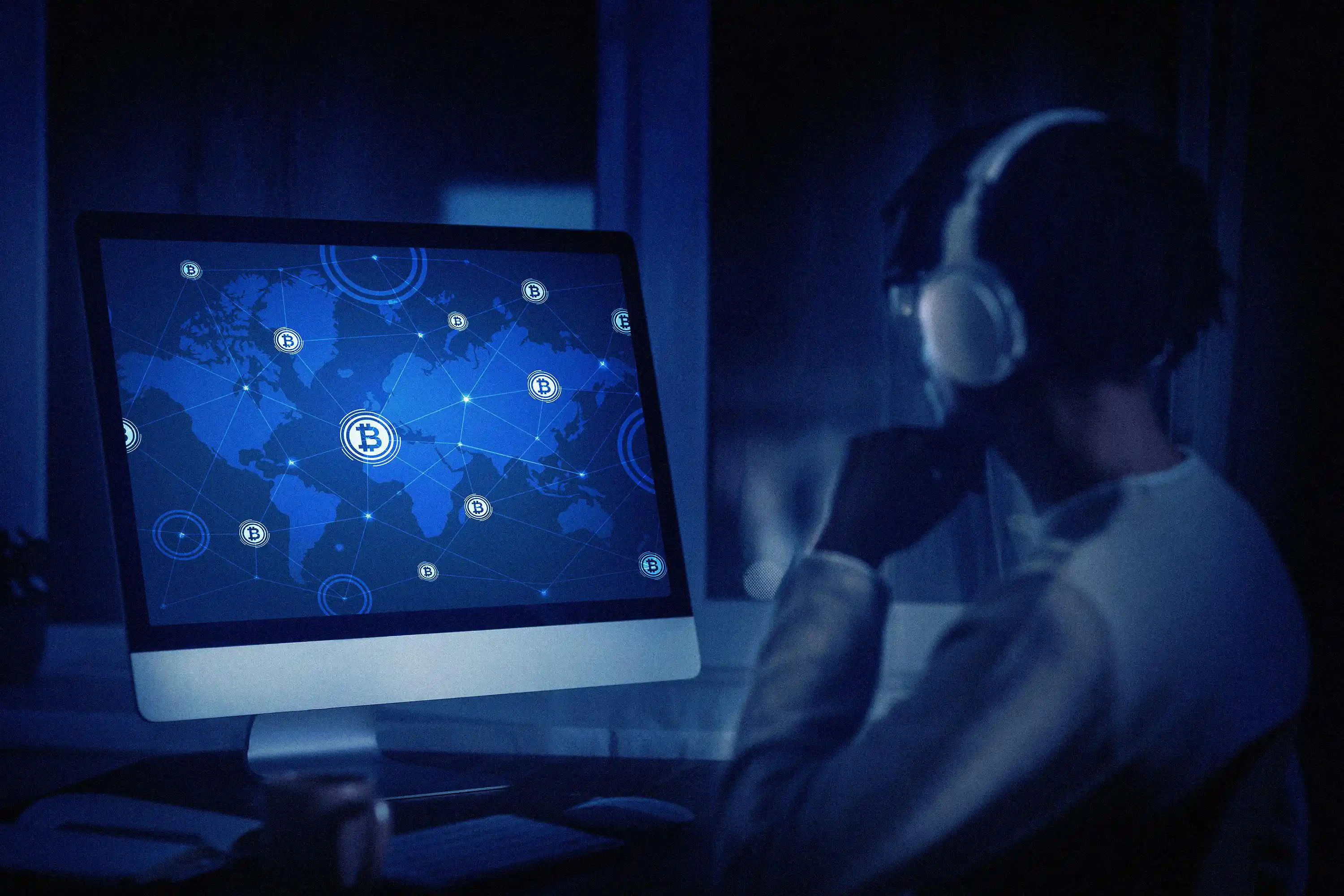The Value of Real-World Assets Tokenization in Today's Economy
May 6, 2024



In today's dynamic economic landscape, the cost of real-world assets has garnered tremendous interest and scrutiny. The worldwide financial system is constantly evolving and dealing with various demanding situations, including inflation, technological disruption, and world political tensions. Buyers and policymakers alike are reevaluating the position and importance of actual belongings. Real-world belongings embody a considerable spectrum, consisting of real assets, infrastructure, commodities, and natural resources, each with its own particular traits and capability for value creation. The dynamics and implications of real-world assets are vital for navigating today's economic environment and capitalizing on investment opportunities.
What Are Real World Assets, And Why Has Tokenization Made Them Important?
Real-world assets include tangible and intangible gadgets, such as real property and art, patents, and copyrights. The emergence of asset tokenization, which entails converting rights to an asset into digital tokens on a blockchain, has transformed how belongings are handled, traded, and perceived. This digital transformation has unlocked new tiers of liquidity, accessibility, and performance in asset management.
Diverse Asset Range: Real-world assets consist of anything of value that exists physically or as a definable entity inside prisons, financial institutions, or cultural nation-states. These belongings range from tangible gadgets like buildings and land to intangible assets like intellectual assets and brand fees.
Tokenization as a Game-Changer: Tokenization divides the ownership of those assets into digital tokens, making them more reachable and more accessible to change. This procedure has democratized funding for excessive-cost assets, permitting broader participation and fractional ownership.
Increased Liquidity and Market Expansion: By converting real-world assets into tokens, their marketability and liquidity are appreciably stronger, opening funding opportunities to a wider audience. Tokenization breaks down traditional barriers to entry, including high minimal funding thresholds, making it less difficult for individuals to spend money on previously inaccessible belongings.
The Real-World Asset Tokenization Process And Why It Is Different
The tokenization of real-world belongings entails a unique combination of traditional asset management and present-day blockchain technology, presenting a revolutionary method of asset ownership and funding.
Conversion into Digital Tokens: Real-world assets are tokenized by issuing virtual tokens that represent a proportion or stake in the asset. Tokens are recorded on a blockchain, which ensures stable and transparent tracking of ownership and transactions. Kaleido makes it easy to tokenize an asset from start to finish.
Blockchain as an Enabling Technology: The use of blockchain technology in tokenization ensures immutability, transparency, and transaction protection. Using blockchain, all token transactions are recorded and decentralized on a decentralized ledger, preventing fraud.
Different from Traditional Asset Management: conventional strategies of managing and trading assets, tokenization affords accelerated performance, fractional ownership, and international accessibility. This current technique of asset control democratizes the right of entry and simplifies the complex processes of buying, promoting, and shifting possessions.
Benefits Of Real-World Asset Tokenization
Tokenization brings a myriad of blessings to asset management, changing the panorama of funding and ownership.
Enhanced Liquidity: Tokenization will make previously illiquid assets more liquid, enabling them to be sold with ease. New markets and funding options are made available by this liquidity transformation, particularly for high-value assets like real estate.
Fractional Ownership: Tokenization enables fractional possession, permitting a couple of buyers to preserve a stake in an asset. This technique lowers the barrier to access for traders, democratizing the right of entry to funding possibilities that were formerly out of reach for many.
Improved Transparency and Efficiency: The use of blockchain in tokenization ensures that each transaction is transparent and green. The immutable report of possession and transactions reduces the chances of disputes and fraud, streamlining asset management techniques.
Industries Using Real-World Assets
Various industries are leveraging the energy of real international asset tokenization to transform their operations and open up new marketplace possibilities.
Real Estate: In real estate enterprises, tokenization is revolutionizing belongings, possessions, and investments, making them more reachable and flexible. Tokenizing assets allows for fractional ownership and less complicated liquidity, making tangible asset funding more achievable for a broader target audience.
Art and Collectibles: The art world uses tokenization to manage the ownership of artworks and collectibles, presenting a brand new way for artists and collectors to monetize and invest in art. Tokenization not only simplifies the shopping for and selling of art but also helps prove its authenticity and provenance.
Finance and Investment: This financial quarter, the industry is adopting tokenization for assets like bonds, shares, and commodities, streamlining investment tactics and improving marketplace efficiency. This innovation is creating more dynamic and inclusive monetary markets.

Blockchain Protocols Used to Tokenize Real-World Assets
The blockchain protocols facilitate the tokenization of real-world assets, each offering excellent capabilities suitable for unique asset styles.
Ethereum: smart contract competencies make it a popular choice for asset tokenization, particularly with its ERC-20 and ERC-721 token requirements. These standards offer inspiration for creating fungible and non-fungible tokens, among other things.
Hyperledger Fabric: Organizations seeking a more private, permissioned blockchain environment should consider Hyperledger Fabric. Its modularity and flexibility are best for groups that require custom-designed tokenization solutions.
Corda: Created using R3, Corda is tailored for the economic enterprise, presenting functions like privacy, scalability, and interoperability. It is designed to facilitate direct and stable transactions among organizations.
Quorum: Originally developed using J.P. Morgan and now maintained by Consensus, Quorum is an open-supply blockchain platform that mixes the innovation of the public Ethereum network with improvements to aid employer needs. It emphasizes privacy, permissions, and overall performance.
Hyperledger Besu: An Ethereum patron designed for company use, Hyperledger Besu helps each permissionless network. It provides a platform for growing programs with a modular and flexible structure.
Conclusion
Real-world tokenization represents a paradigm shift in how we perceive and interact with tangible and intangible assets. Asset tokenization has democratized funding possibilities, increased liquidity, and improved transparency and performance in asset management by leveraging blockchain development. Industries spanning from real estate to finance are embracing this innovation, creating new market possibilities, and reshaping traditional enterprise models. As diverse blockchain protocols continue to evolve, the landscape of asset tokenization will similarly expand, imparting tailor-made answers to meet the precise wishes of various asset classes and industries. Blockchain development is at the centre of this change, using innovation and allowing stable, decentralized transactions. The continuing exploration and adoption of real-world asset tokenization, coupled with improvements in blockchain development, will undoubtedly redefine the future of funding and ownership, fostering extra inclusivity and efficiency in the world economy.
In today's dynamic economic landscape, the cost of real-world assets has garnered tremendous interest and scrutiny. The worldwide financial system is constantly evolving and dealing with various demanding situations, including inflation, technological disruption, and world political tensions. Buyers and policymakers alike are reevaluating the position and importance of actual belongings. Real-world belongings embody a considerable spectrum, consisting of real assets, infrastructure, commodities, and natural resources, each with its own particular traits and capability for value creation. The dynamics and implications of real-world assets are vital for navigating today's economic environment and capitalizing on investment opportunities.
What Are Real World Assets, And Why Has Tokenization Made Them Important?
Real-world assets include tangible and intangible gadgets, such as real property and art, patents, and copyrights. The emergence of asset tokenization, which entails converting rights to an asset into digital tokens on a blockchain, has transformed how belongings are handled, traded, and perceived. This digital transformation has unlocked new tiers of liquidity, accessibility, and performance in asset management.
Diverse Asset Range: Real-world assets consist of anything of value that exists physically or as a definable entity inside prisons, financial institutions, or cultural nation-states. These belongings range from tangible gadgets like buildings and land to intangible assets like intellectual assets and brand fees.
Tokenization as a Game-Changer: Tokenization divides the ownership of those assets into digital tokens, making them more reachable and more accessible to change. This procedure has democratized funding for excessive-cost assets, permitting broader participation and fractional ownership.
Increased Liquidity and Market Expansion: By converting real-world assets into tokens, their marketability and liquidity are appreciably stronger, opening funding opportunities to a wider audience. Tokenization breaks down traditional barriers to entry, including high minimal funding thresholds, making it less difficult for individuals to spend money on previously inaccessible belongings.
The Real-World Asset Tokenization Process And Why It Is Different
The tokenization of real-world belongings entails a unique combination of traditional asset management and present-day blockchain technology, presenting a revolutionary method of asset ownership and funding.
Conversion into Digital Tokens: Real-world assets are tokenized by issuing virtual tokens that represent a proportion or stake in the asset. Tokens are recorded on a blockchain, which ensures stable and transparent tracking of ownership and transactions. Kaleido makes it easy to tokenize an asset from start to finish.
Blockchain as an Enabling Technology: The use of blockchain technology in tokenization ensures immutability, transparency, and transaction protection. Using blockchain, all token transactions are recorded and decentralized on a decentralized ledger, preventing fraud.
Different from Traditional Asset Management: conventional strategies of managing and trading assets, tokenization affords accelerated performance, fractional ownership, and international accessibility. This current technique of asset control democratizes the right of entry and simplifies the complex processes of buying, promoting, and shifting possessions.
Benefits Of Real-World Asset Tokenization
Tokenization brings a myriad of blessings to asset management, changing the panorama of funding and ownership.
Enhanced Liquidity: Tokenization will make previously illiquid assets more liquid, enabling them to be sold with ease. New markets and funding options are made available by this liquidity transformation, particularly for high-value assets like real estate.
Fractional Ownership: Tokenization enables fractional possession, permitting a couple of buyers to preserve a stake in an asset. This technique lowers the barrier to access for traders, democratizing the right of entry to funding possibilities that were formerly out of reach for many.
Improved Transparency and Efficiency: The use of blockchain in tokenization ensures that each transaction is transparent and green. The immutable report of possession and transactions reduces the chances of disputes and fraud, streamlining asset management techniques.
Industries Using Real-World Assets
Various industries are leveraging the energy of real international asset tokenization to transform their operations and open up new marketplace possibilities.
Real Estate: In real estate enterprises, tokenization is revolutionizing belongings, possessions, and investments, making them more reachable and flexible. Tokenizing assets allows for fractional ownership and less complicated liquidity, making tangible asset funding more achievable for a broader target audience.
Art and Collectibles: The art world uses tokenization to manage the ownership of artworks and collectibles, presenting a brand new way for artists and collectors to monetize and invest in art. Tokenization not only simplifies the shopping for and selling of art but also helps prove its authenticity and provenance.
Finance and Investment: This financial quarter, the industry is adopting tokenization for assets like bonds, shares, and commodities, streamlining investment tactics and improving marketplace efficiency. This innovation is creating more dynamic and inclusive monetary markets.

Blockchain Protocols Used to Tokenize Real-World Assets
The blockchain protocols facilitate the tokenization of real-world assets, each offering excellent capabilities suitable for unique asset styles.
Ethereum: smart contract competencies make it a popular choice for asset tokenization, particularly with its ERC-20 and ERC-721 token requirements. These standards offer inspiration for creating fungible and non-fungible tokens, among other things.
Hyperledger Fabric: Organizations seeking a more private, permissioned blockchain environment should consider Hyperledger Fabric. Its modularity and flexibility are best for groups that require custom-designed tokenization solutions.
Corda: Created using R3, Corda is tailored for the economic enterprise, presenting functions like privacy, scalability, and interoperability. It is designed to facilitate direct and stable transactions among organizations.
Quorum: Originally developed using J.P. Morgan and now maintained by Consensus, Quorum is an open-supply blockchain platform that mixes the innovation of the public Ethereum network with improvements to aid employer needs. It emphasizes privacy, permissions, and overall performance.
Hyperledger Besu: An Ethereum patron designed for company use, Hyperledger Besu helps each permissionless network. It provides a platform for growing programs with a modular and flexible structure.
Conclusion
Real-world tokenization represents a paradigm shift in how we perceive and interact with tangible and intangible assets. Asset tokenization has democratized funding possibilities, increased liquidity, and improved transparency and performance in asset management by leveraging blockchain development. Industries spanning from real estate to finance are embracing this innovation, creating new market possibilities, and reshaping traditional enterprise models. As diverse blockchain protocols continue to evolve, the landscape of asset tokenization will similarly expand, imparting tailor-made answers to meet the precise wishes of various asset classes and industries. Blockchain development is at the centre of this change, using innovation and allowing stable, decentralized transactions. The continuing exploration and adoption of real-world asset tokenization, coupled with improvements in blockchain development, will undoubtedly redefine the future of funding and ownership, fostering extra inclusivity and efficiency in the world economy.
In today's dynamic economic landscape, the cost of real-world assets has garnered tremendous interest and scrutiny. The worldwide financial system is constantly evolving and dealing with various demanding situations, including inflation, technological disruption, and world political tensions. Buyers and policymakers alike are reevaluating the position and importance of actual belongings. Real-world belongings embody a considerable spectrum, consisting of real assets, infrastructure, commodities, and natural resources, each with its own particular traits and capability for value creation. The dynamics and implications of real-world assets are vital for navigating today's economic environment and capitalizing on investment opportunities.
What Are Real World Assets, And Why Has Tokenization Made Them Important?
Real-world assets include tangible and intangible gadgets, such as real property and art, patents, and copyrights. The emergence of asset tokenization, which entails converting rights to an asset into digital tokens on a blockchain, has transformed how belongings are handled, traded, and perceived. This digital transformation has unlocked new tiers of liquidity, accessibility, and performance in asset management.
Diverse Asset Range: Real-world assets consist of anything of value that exists physically or as a definable entity inside prisons, financial institutions, or cultural nation-states. These belongings range from tangible gadgets like buildings and land to intangible assets like intellectual assets and brand fees.
Tokenization as a Game-Changer: Tokenization divides the ownership of those assets into digital tokens, making them more reachable and more accessible to change. This procedure has democratized funding for excessive-cost assets, permitting broader participation and fractional ownership.
Increased Liquidity and Market Expansion: By converting real-world assets into tokens, their marketability and liquidity are appreciably stronger, opening funding opportunities to a wider audience. Tokenization breaks down traditional barriers to entry, including high minimal funding thresholds, making it less difficult for individuals to spend money on previously inaccessible belongings.
The Real-World Asset Tokenization Process And Why It Is Different
The tokenization of real-world belongings entails a unique combination of traditional asset management and present-day blockchain technology, presenting a revolutionary method of asset ownership and funding.
Conversion into Digital Tokens: Real-world assets are tokenized by issuing virtual tokens that represent a proportion or stake in the asset. Tokens are recorded on a blockchain, which ensures stable and transparent tracking of ownership and transactions. Kaleido makes it easy to tokenize an asset from start to finish.
Blockchain as an Enabling Technology: The use of blockchain technology in tokenization ensures immutability, transparency, and transaction protection. Using blockchain, all token transactions are recorded and decentralized on a decentralized ledger, preventing fraud.
Different from Traditional Asset Management: conventional strategies of managing and trading assets, tokenization affords accelerated performance, fractional ownership, and international accessibility. This current technique of asset control democratizes the right of entry and simplifies the complex processes of buying, promoting, and shifting possessions.
Benefits Of Real-World Asset Tokenization
Tokenization brings a myriad of blessings to asset management, changing the panorama of funding and ownership.
Enhanced Liquidity: Tokenization will make previously illiquid assets more liquid, enabling them to be sold with ease. New markets and funding options are made available by this liquidity transformation, particularly for high-value assets like real estate.
Fractional Ownership: Tokenization enables fractional possession, permitting a couple of buyers to preserve a stake in an asset. This technique lowers the barrier to access for traders, democratizing the right of entry to funding possibilities that were formerly out of reach for many.
Improved Transparency and Efficiency: The use of blockchain in tokenization ensures that each transaction is transparent and green. The immutable report of possession and transactions reduces the chances of disputes and fraud, streamlining asset management techniques.
Industries Using Real-World Assets
Various industries are leveraging the energy of real international asset tokenization to transform their operations and open up new marketplace possibilities.
Real Estate: In real estate enterprises, tokenization is revolutionizing belongings, possessions, and investments, making them more reachable and flexible. Tokenizing assets allows for fractional ownership and less complicated liquidity, making tangible asset funding more achievable for a broader target audience.
Art and Collectibles: The art world uses tokenization to manage the ownership of artworks and collectibles, presenting a brand new way for artists and collectors to monetize and invest in art. Tokenization not only simplifies the shopping for and selling of art but also helps prove its authenticity and provenance.
Finance and Investment: This financial quarter, the industry is adopting tokenization for assets like bonds, shares, and commodities, streamlining investment tactics and improving marketplace efficiency. This innovation is creating more dynamic and inclusive monetary markets.

Blockchain Protocols Used to Tokenize Real-World Assets
The blockchain protocols facilitate the tokenization of real-world assets, each offering excellent capabilities suitable for unique asset styles.
Ethereum: smart contract competencies make it a popular choice for asset tokenization, particularly with its ERC-20 and ERC-721 token requirements. These standards offer inspiration for creating fungible and non-fungible tokens, among other things.
Hyperledger Fabric: Organizations seeking a more private, permissioned blockchain environment should consider Hyperledger Fabric. Its modularity and flexibility are best for groups that require custom-designed tokenization solutions.
Corda: Created using R3, Corda is tailored for the economic enterprise, presenting functions like privacy, scalability, and interoperability. It is designed to facilitate direct and stable transactions among organizations.
Quorum: Originally developed using J.P. Morgan and now maintained by Consensus, Quorum is an open-supply blockchain platform that mixes the innovation of the public Ethereum network with improvements to aid employer needs. It emphasizes privacy, permissions, and overall performance.
Hyperledger Besu: An Ethereum patron designed for company use, Hyperledger Besu helps each permissionless network. It provides a platform for growing programs with a modular and flexible structure.
Conclusion
Real-world tokenization represents a paradigm shift in how we perceive and interact with tangible and intangible assets. Asset tokenization has democratized funding possibilities, increased liquidity, and improved transparency and performance in asset management by leveraging blockchain development. Industries spanning from real estate to finance are embracing this innovation, creating new market possibilities, and reshaping traditional enterprise models. As diverse blockchain protocols continue to evolve, the landscape of asset tokenization will similarly expand, imparting tailor-made answers to meet the precise wishes of various asset classes and industries. Blockchain development is at the centre of this change, using innovation and allowing stable, decentralized transactions. The continuing exploration and adoption of real-world asset tokenization, coupled with improvements in blockchain development, will undoubtedly redefine the future of funding and ownership, fostering extra inclusivity and efficiency in the world economy.

DecentraBlock is at the forefront of blockchain innovation, revolutionizing how businesses secure, transact, and grow in the digital age. Join us on a journey to harness the full potential of decentralized technology for a more efficient and transparent future.
Services
Subscribe to Our Newsletter
Get the latest news, updates, and insights on blockchain technology directly to your inbox. Sign up for our newsletter today!
© 2024 DecentraBlock. All rights reserved.

DecentraBlock is at the forefront of blockchain innovation, revolutionizing how businesses secure, transact, and grow in the digital age. Join us on a journey to harness the full potential of decentralized technology for a more efficient and transparent future.
Services
Subscribe to Our Newsletter
Get the latest news, updates, and insights on blockchain technology directly to your inbox. Sign up for our newsletter today!
© 2024 DecentraBlock. All rights reserved.

DecentraBlock is at the forefront of blockchain innovation, revolutionizing how businesses secure, transact, and grow in the digital age. Join us on a journey to harness the full potential of decentralized technology for a more efficient and transparent future.
Services
Subscribe to Our Newsletter
Get the latest news, updates, and insights on blockchain technology directly to your inbox. Sign up for our newsletter today!
© 2024 DecentraBlock. All rights reserved.


